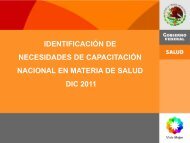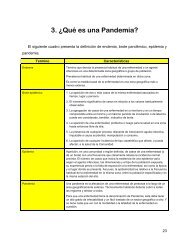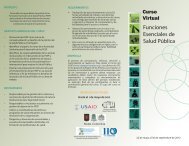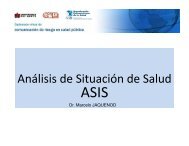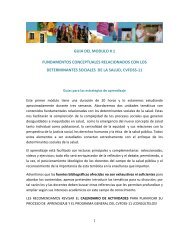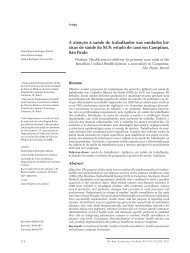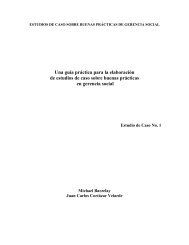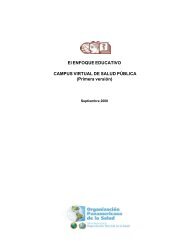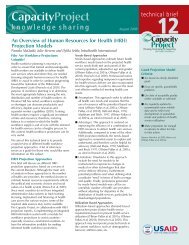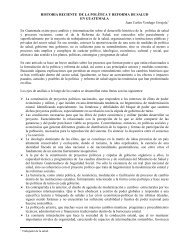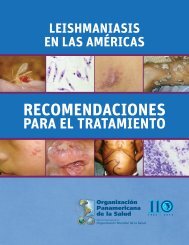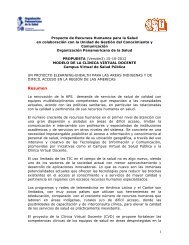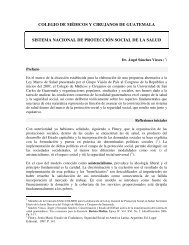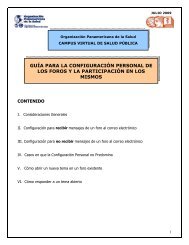Análisis de la situación de salud - Aula Virtual Regional. Campus ...
Análisis de la situación de salud - Aula Virtual Regional. Campus ...
Análisis de la situación de salud - Aula Virtual Regional. Campus ...
Create successful ePaper yourself
Turn your PDF publications into a flip-book with our unique Google optimized e-Paper software.
Informe Anual <strong>de</strong>l Director – 2000<br />
EL PROGRESO EN LA SALUD DE LA POBLACIÓN<br />
Organización Panamericana <strong>de</strong> <strong>la</strong> Salud<br />
FIGURA 6a. Corre<strong>la</strong>ción entre <strong>la</strong> tasa <strong>de</strong> mortalidad<br />
infantil y el grado <strong>de</strong> acceso a servicios <strong>de</strong><br />
abastecimiento <strong>de</strong> agua potable, Perú, 1996.<br />
Tasa <strong>de</strong> mortalidad infantil<br />
(<strong>de</strong>funciones por 1.000 nacidos vivos)<br />
120<br />
100<br />
80<br />
60<br />
40<br />
20<br />
Coeficiente <strong>de</strong> corre<strong>la</strong>ción = –0,65<br />
0<br />
0 20 40 60 80 100<br />
Pob<strong>la</strong>ción con acceso a servicios <strong>de</strong><br />
abastecimiento <strong>de</strong> agua potable (%)<br />
FIGURA 6b. Corre<strong>la</strong>ción entre <strong>la</strong> tasa <strong>de</strong> mortalidad<br />
infantil y el grado <strong>de</strong> acceso a servicios <strong>de</strong><br />
abastecimiento <strong>de</strong> agua potable, Brasil, 1997.<br />
Tasa <strong>de</strong> mortalidad infantil<br />
(<strong>de</strong>funciones por 1.000 nacidos vivos)<br />
80<br />
60<br />
40<br />
20<br />
0<br />
Coeficiente <strong>de</strong> corre<strong>la</strong>ción = –0,66<br />
0 20 40 60 80 100<br />
Pob<strong>la</strong>ción con acceso a servicios <strong>de</strong><br />
abastecimiento <strong>de</strong> agua potable (%)<br />
FIGURA 7a. Corre<strong>la</strong>ción entre <strong>la</strong> tasa <strong>de</strong> mortalidad<br />
infantil y el grado <strong>de</strong> acceso a servicios <strong>de</strong><br />
eliminación <strong>de</strong> excretas, Panamá, 1996.<br />
Tasa <strong>de</strong> mortalidad infantil<br />
(<strong>de</strong>funciones por 1.000 nacidos vivos)<br />
40<br />
32<br />
24<br />
16<br />
8<br />
0<br />
Coeficiente <strong>de</strong> corre<strong>la</strong>ción = –0,80<br />
0 20 40 60 80 100<br />
Pob<strong>la</strong>ción con acceso a servicios<br />
<strong>de</strong> eliminación <strong>de</strong> excretas (%)<br />
<strong>de</strong>s en <strong>salud</strong> en el interior <strong>de</strong> un país. El análisis exploratorio<br />
<strong>de</strong> <strong>la</strong>s <strong>de</strong>sigualda<strong>de</strong>s en <strong>salud</strong> se realizó utilizando<br />
<strong>la</strong> curva <strong>de</strong> Lorenz 2 y el coeficiente <strong>de</strong> Gini. 3 Con datos<br />
<strong>de</strong> 27 regiones <strong>de</strong> <strong>salud</strong> <strong>de</strong> Guatema<strong>la</strong> y <strong>de</strong> 18 <strong>de</strong>partamentos<br />
<strong>de</strong>l Uruguay, <strong>la</strong>s figuras 9a y 9b muestran <strong>la</strong> magnitud<br />
y <strong>la</strong> distribución <strong>de</strong> <strong>la</strong>s <strong>de</strong>sigualda<strong>de</strong>s en <strong>la</strong> tasa <strong>de</strong><br />
mortalidad infantil en esos dos países. En una <strong>situación</strong><br />
<strong>de</strong> “perfecta igualdad”, cada quintil <strong>de</strong> <strong>la</strong> pob<strong>la</strong>ción<br />
<strong>de</strong>be representar so<strong>la</strong>mente 20% <strong>de</strong>l total <strong>de</strong> <strong>de</strong>funciones.<br />
Sin embargo, estas curvas <strong>de</strong> Lorenz muestran que<br />
casi 35% <strong>de</strong> <strong>la</strong>s <strong>de</strong>funciones infantiles en Guatema<strong>la</strong> y<br />
25% <strong>de</strong> <strong>la</strong>s registradas en el Uruguay se presentan en el<br />
quintil más alto <strong>de</strong> <strong>la</strong> tasa <strong>de</strong> mortalidad infantil. Al examinar<br />
el extremo opuesto <strong>de</strong> <strong>la</strong> distribución, el quintil<br />
más bajo <strong>de</strong> <strong>la</strong> tasa <strong>de</strong> mortalidad infantil en Guatema<strong>la</strong><br />
representa so<strong>la</strong>mente 10% <strong>de</strong> <strong>la</strong>s <strong>de</strong>funciones infantiles<br />
y en el Uruguay, 15%. Estas disparida<strong>de</strong>s internas también<br />
se expresan como una razón entre los quintiles extremos<br />
(<strong>la</strong> razón entre el 20% superior y el 20% inferior):<br />
<strong>la</strong> <strong>de</strong> Guatema<strong>la</strong> es <strong>de</strong> 3,5 y <strong>la</strong> <strong>de</strong>l Uruguay <strong>de</strong> 1,6. El<br />
coeficiente <strong>de</strong> Gini es una medida resumida <strong>de</strong> esas <strong>de</strong>sigualda<strong>de</strong>s.<br />
Los valores <strong>de</strong>l coeficiente <strong>de</strong> Gini son <strong>de</strong> 0,22<br />
para Guatema<strong>la</strong> y <strong>de</strong> 0,09 para el Uruguay. Sin embargo,<br />
el coeficiente <strong>de</strong> Gini no incluye los factores socioeconómicos<br />
en <strong>la</strong> evaluación <strong>de</strong> <strong>la</strong>s <strong>de</strong>sigualda<strong>de</strong>s en <strong>salud</strong> y,<br />
por tanto, no es posible <strong>de</strong>terminar si el quintil más alto<br />
<strong>de</strong> <strong>la</strong> tasa <strong>de</strong> mortalidad infantil representa en realidad<br />
el quintil más pobre <strong>de</strong> <strong>la</strong> pob<strong>la</strong>ción.<br />
Por contraste, los datos básicos <strong>de</strong> <strong>salud</strong>, <strong>de</strong>sagregados<br />
en el nivel subnacional, facilitaron <strong>la</strong> exploración <strong>de</strong>l<br />
grado <strong>de</strong> distribución interna <strong>de</strong> <strong>la</strong>s <strong>de</strong>sigualda<strong>de</strong>s en<br />
<strong>salud</strong>, teniendo en cuenta importantes variables socioeconómicas.<br />
La pob<strong>la</strong>ción se c<strong>la</strong>sificó en una jerarquía<br />
socioeconómica según los valores <strong>de</strong> uno <strong>de</strong> los tres factores<br />
<strong>de</strong>terminantes <strong>de</strong> <strong>la</strong> <strong>salud</strong>: <strong>la</strong> pobreza, el acceso a<br />
agua potable y el índice <strong>de</strong> <strong>de</strong>sarrollo social. Luego se estableció<br />
una re<strong>la</strong>ción entre esa jerarquía socioeconómica<br />
y <strong>la</strong> distribución observada <strong>de</strong> <strong>la</strong> tasa <strong>de</strong> mortalidad infantil,<br />
una importante variable <strong>de</strong> los resultados <strong>de</strong> <strong>salud</strong>.<br />
Este método analítico se expresa por medio <strong>de</strong> <strong>la</strong> curva<br />
2 La curva <strong>de</strong> Lorenz muestra <strong>la</strong> diferencia entre dos distribuciones. Cuando <strong>la</strong> proporción en cada quintil<br />
<strong>de</strong> <strong>la</strong> variable <strong>de</strong>l eje y es igual a <strong>la</strong> proporción en cada quintil <strong>de</strong> <strong>la</strong> variable <strong>de</strong>l eje x, los valores trazan<br />
una línea <strong>de</strong> 45 grados. El grado <strong>de</strong> curvatura indica el grado <strong>de</strong> diferencia (<strong>de</strong>sigualdad) entre <strong>la</strong>s<br />
dos proporciones.<br />
3 El coeficiente <strong>de</strong> Gini, una medida resumida <strong>de</strong> <strong>la</strong> <strong>de</strong>sviación en <strong>la</strong> curva <strong>de</strong> Lorenz, es <strong>la</strong> razón <strong>de</strong> <strong>la</strong><br />
superficie comprendida entre <strong>la</strong> curva <strong>de</strong> Lorenz y <strong>la</strong> línea <strong>de</strong> 45 grados y toda <strong>la</strong> superficie situada por<br />
encima o por <strong>de</strong>bajo <strong>de</strong> esa línea. Si <strong>la</strong> curva <strong>de</strong> Lorenz está en <strong>la</strong> línea <strong>de</strong> 45 grados, el valor <strong>de</strong>l coeficiente<br />
<strong>de</strong> Gini es <strong>de</strong> cero. A medida que aumenta <strong>la</strong> <strong>de</strong>sviación, sube el coeficiente <strong>de</strong> Gini; el valor máximo<br />
posible <strong>de</strong> este coeficiente es <strong>de</strong> 1.<br />
12



